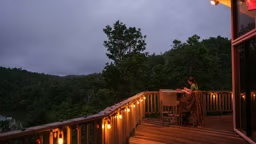Besides soaking up excess water, rain gardens offer cabin owners additional benefits. They reduce the need for irrigation, because they use and optimize any rain that falls. Rain gardens also spruce up a dull yard with the addition of colorful and attractive native wildflowers and grasses, which in turn, attract butterflies and birds. Another nice advantage of rain gardens is that your cabin property will not be a breeding ground for pesky mosquitoes! The standing water needed for hatching mosquitoes is eliminated, as the water soaks into the ground within 24 to 48 hours. And lastly, planting wetland vegetation near the water’s edge not only helps keep the shoreline from eroding by protecting the bank from wave action, but the cleaner water that results from rain gardens also encourages the development of fish habitats.
The Walseths dug and planted the rain gardens themselves in only a few days time. Making plant selections was the most time-consuming part of the process.
“I researched to be sure I had the right plants in the right places. Plus, I wanted color in the spring, summer and fall,” says Kris, who notes that the gardens even look good in the dead of winter. “The seed heads are pretty with the snow on them.”
The Walseths are certainly pleased with the success of their rain gardens. And now when they peer out their cabin window, they have another thought: “What beautiful gardens!”
Freelancer Christy Heitger admits she has no green thumb, but she likes to brag about how she once kept an African Violet alive in her office for three years straight (a personal record).
The Walseths dug and planted the rain gardens themselves in only a few days time. Making plant selections was the most time-consuming part of the process.
“I researched to be sure I had the right plants in the right places. Plus, I wanted color in the spring, summer and fall,” says Kris, who notes that the gardens even look good in the dead of winter. “The seed heads are pretty with the snow on them.”
The Walseths are certainly pleased with the success of their rain gardens. And now when they peer out their cabin window, they have another thought: “What beautiful gardens!”
Freelancer Christy Heitger admits she has no green thumb, but she likes to brag about how she once kept an African Violet alive in her office for three years straight (a personal record).
Every time Kris and Dan Walseth gaze out their cabin window they think, “What a beautiful lake!”
To keep it that way, they put in a rain garden – well, five to be exact – of various sizes on their cabin property near Crosby, Minn.
“We just wanted to be good stewards of the lake and the land,” says Kris. “And we knew rain gardens were a great way to do that.”
Unlike a typical flower garden, a rain garden is a planted depression designed to take much of the excess rainwater run-off from a building and its associated landscape, preventing it from running into a natural waterbody or watershed. This is important because substances like phosphorus (found in lawn and garden fertilizers) can get washed into natural waterbodies with the rainfall runoff. Too much phosphorus in lakes, rivers and streams can cause prolific algae blooms and can be fatal to fish. In addition to phosphorous, other types of runoff contaminents (also called nonpoint source pollution) include soil sediment, bacteria, pesticides, pet waste and oil.
The plants – a selection of native vegetation, such as sedges, ferns, shrubs and trees – absorb the excess water as it slowly filters into the ground.
To keep it that way, they put in a rain garden – well, five to be exact – of various sizes on their cabin property near Crosby, Minn.
“We just wanted to be good stewards of the lake and the land,” says Kris. “And we knew rain gardens were a great way to do that.”
Unlike a typical flower garden, a rain garden is a planted depression designed to take much of the excess rainwater run-off from a building and its associated landscape, preventing it from running into a natural waterbody or watershed. This is important because substances like phosphorus (found in lawn and garden fertilizers) can get washed into natural waterbodies with the rainfall runoff. Too much phosphorus in lakes, rivers and streams can cause prolific algae blooms and can be fatal to fish. In addition to phosphorous, other types of runoff contaminents (also called nonpoint source pollution) include soil sediment, bacteria, pesticides, pet waste and oil.
The plants – a selection of native vegetation, such as sedges, ferns, shrubs and trees – absorb the excess water as it slowly filters into the ground.
 Paul Gregerson
Paul Gregerson 
 Paul Gregerson
Paul Gregerson 









